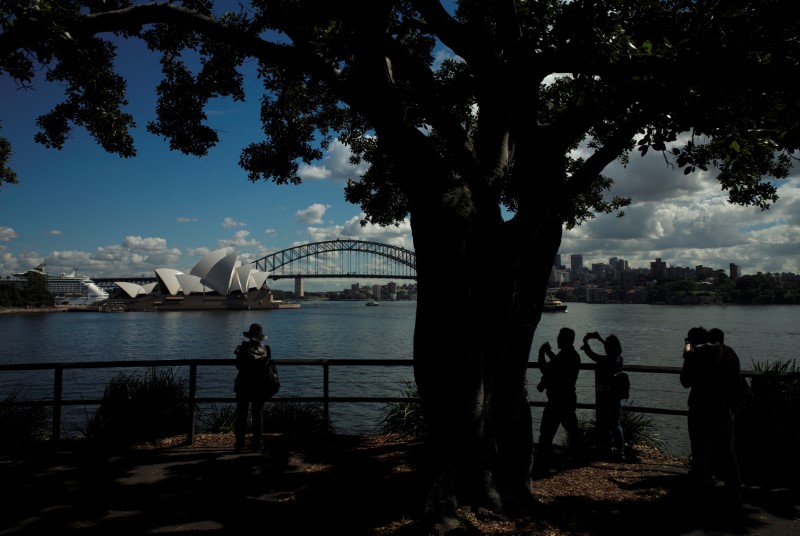(Bloomberg) -- Australia’s record run without a technical recession -- defined locally as two consecutive quarters of contraction -- has a slim chance of continuing in what would be another dramatic escape for the world’s longest economic growth streak.
Frenzied stockpiling of food, toilet paper and other household items ahead of the coronavirus lockdown boosted spending in the first quarter. And exports surged in March while imports fell. Those factors may just be enough to have kept the economy growing during the first three months of 2020.
“It’s not my base case, but it’s a possibility,” said Shane Oliver, chief economist at AMP (OTC:AMLTF) Capital Investors Ltd. in Sydney. “If you look at the high-frequency economic activity data, the low point was early April, since then we’ve been starting to head up.”
While the second quarter will undoubtedly be ugly as businesses shut down and tens of thousands lost their jobs, government support packages and success in curbing the pandemic are raising hopes for a third quarter rebound.
Australia hasn’t seen a recession for 28-1/2 years. During the global financial crisis, the economy was belted in the final three months of 2008 before government cash handouts drove a surge in household spending and a return to growth in the first quarter of 2009. Similarly, as recession gripped Europe and then America in the early 2000s, Australia escaped with just the one quarter-on-quarter contraction in the final three months of 2000.
While quarterly retail sales volumes released Wednesday didn’t rise as high as forecast, they still suggest a positive contribution to GDP. Trade data for the quarter suggest import volumes fell more than export volumes, implying net exports could add to GDP as well.
The key issue is whether the worst data is confined to the present quarter after Australia closed pubs, restaurants and casinos on March 23, then broadened the restrictions to all non-essential services from the next day.
The median estimate in Bloomberg’s survey of economists is for GDP to decline 0.4% in the first three months of 2020 and then slump 6.8% in the following three months. Bloomberg Economics forecasts falls of 1% and 8% respectively. The Reserve Bank of Australia is penciling in a 10% fall in output in the first half of this year.
“At the moment, the contraction in the first quarter is not completely convincing,” said Paul Bloxham, chief economist for Australia at HSBC Holdings Plc (LON:HSBA). “It’s early because you haven’t got a lot of the partials,” he said, referring to data like business investment, inventories and other inputs that make up GDP.
The release of these other partial indicators in the run-up to first-quarter GDP on Wednesday, June 3, will give economists a clearer idea.
Bloxham, who previously worked at the RBA, noted tourism -- decimated by border closures -- could work in the economy’s favor because Australians spend more when traveling abroad than the nation reaps from its incoming tourists.
“So keeping all those Australians from traveling reduces imports,” he said.
First Quarter
Australian business confidence plummeted in March to the lowest level in the history, and this will impact investment in the current and future quarters. On the other hand, firms preparing systems for remote working will support spending, as will things like the installation of plastic protection screens and dividers in supermarkets and retailers.
Moreover, unlike in New Zealand, building sites remained open in Australia throughout the lockdown period, so projects already under construction have largely proceeded as planned.
As to broader influences, the drag on the economy from weak residential construction will persist, while the anticipated expansion of the mining industry will be under a cloud. BHP Group (NYSE:BHP) has said capital expenditure in the year to June 30, 2021, will be lower than previously planned.
Wildfire Recovery
As Australians saw in the New Year, wild fires engulfed large swathes of the east coast, forcing the government to deploy military aircraft and ships to help evacuate stranded holidaymakers. This will boost public spending in the first quarter, as will financial relief provided to victims.
The recovery effort also includes rebuilding infrastructure like roads, energy, telecommunications and other assets that should support public investment, and flow through to the private sector.
Inventories could be the swing factor that decides between expansion and contraction in the first quarter. This volatile component has added or cut up to 0.3 percentage point from quarterly GDP in the past two years.
Inventories “are very hard to forecast,” said David Plank, head of Australian economics at Australia & New Zealand Banking Group Ltd. “So while we will get a lift to GDP from the sales of groceries, albeit smaller than we thought, we may get an offset to GDP from a decline in stocks.”
Meaning of Recession
Even if Australia pulls off a great escape and avoids two consecutive quarters of contraction, would it really matter?
Plank said first-quarter growth and no technical recession would be a better than expected outcome, and he also hopes commentators will finally abandon their short-hand definition for recession.
“A much better way to think about it is unemployment,” he said. “If it goes up a lot then we are in recession, regardless.” The jobless rate is forecast by the RBA to reach 10%.
Avoiding consecutive quarterly drops in GDP is just semantics if the economy records the biggest contraction since World War II in a single quarter.
“We could have this weird combination of a horrific, depression-like collapse in the economy in the June quarter, but if it’s not two negative quarters it can’t be called a recession,” Oliver said. “Then you end up debating, ‘well, how can it be a depression if it’s not a technical recession?”’
©2020 Bloomberg L.P.
